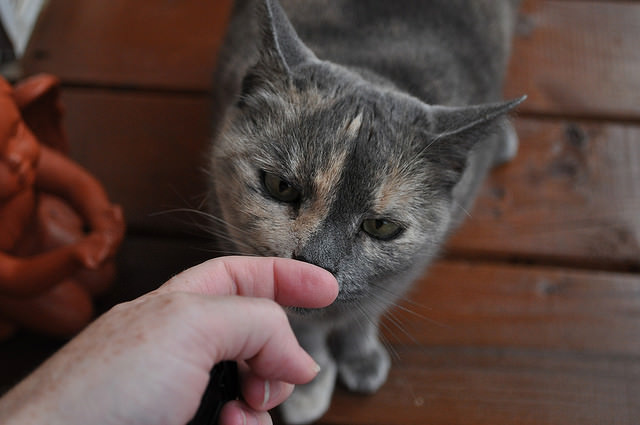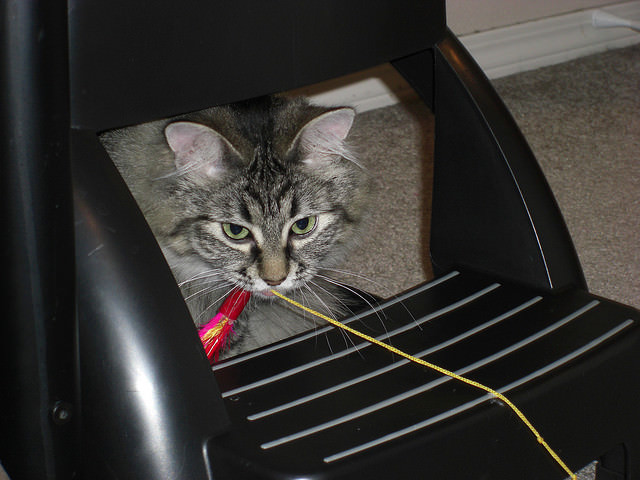Whether a cat was rescued from a situation where she was treated poorly by humans, has never interacted with humans before, has a health issue that is making her act out from stress, or is simply shy by nature, we have a responsibility as caretakers to help our feline friends learn to trust and feel safe in their environments.
It takes a tremendous amount of patience, sensitivity, and care to transition a cat from skittish to secure. The process can be tedious and heartbreaking. All of your hard work will pay off though. And the first time your shy cat rubs up against your legs while you are washing dishes will be one of the best and most rewarding moments of your life.

Image Source: Tina Lawson via Flickr.com
1. Give her a quiet space, complete with the essentials
Shy cats need to ease into situations slowly, so it’s important to make sure she has some space where she can feel safe and protected from all of the sounds, smells, and stimulations of your home. Having a safe space will allow her to explore at her own pace as she builds trust and confidence.
Safe spaces are most commonly created in spare rooms or uncluttered closets. The key is to choose a room or section of your home that gets minimal foot traffic and has a few good hiding spaces. The space should include all of her essentials: a comfy bed, a clean litter box, food, fresh water, a scratching post, and toys.
This is a temporary situation. As she becomes more comfortable with you and your home you should be able to move the litter, food, and water to more appropriate locations.

Image Source: Takashi Hososhima via Flickr.com
2. Be patient
Patience is one of the biggest skills to practice if you want to encourage a shy cat to trust you. Getting frustrated or trying to force your cat into a situation she isn’t ready for will ultimately do more harm than good and can set back any progress she has made. Most importantly, recognize that every cat is different and don’t hold her to the standards or pace of other cats you have known. This cat has her own unique history and her uncertainty is valid.

Image Source: Glenn Beltz via Flickr.com
3. Move slowly and quietly
Shy cats can be easily spooked by loud or sudden movements. When she’s around, practice moving in intentionally slow and quiet ways. Any sudden movements or loud noises can send her back into hiding.

Image Source: Jessica Fiess-Hill via Flickr.com
4. Speak softly and quietly, but speak often
Like sudden or loud movements, shy cats can be spooked by booming voices. When you talk to her, speak with a voice that is soft and calm. Get her used to your voice by speaking to her often. Hearing your calm voice while you clean her space or simply sit with her will help her become more comfortable with you.

Image Source: Wolfgang Lonien via Flickr.com
5. Pay attention to and respect her body language
One of the best ways to build trust is to show her that you respect her need for space and time, and to let her set the pace for interactions. Her body language will give you hints about how she is feeling. Understanding and respecting these signals will help her view you as a trustworthy person.
Give space to a cat that exhibits any of these classic fear/anxiety signs:
- Ears that lay flat against her head
- Fur standing up
- A tail that is either flicking back and forth or laying low and tucked between her legs
- Arched back
- Hissing, spitting, or growling
Attempting to touch a cat who is displaying any of these warning signs can not only cause her to distrust you more, but you can become seriously injured if she strikes.
Alternately, a cat who exhibits the following behavior is relaxed and happy:
- Upright or forward ears
- Erect tail
- Exposed belly
- Rubbing against you

Image Source: VirtKitty via Flickr.com
6. Let her sniff you
Cats gather a lot of information about their environment through their sense of smell. Before touching your shy cat, put your hand out (palm down and relaxed so it is minimally threatening) and allow her to sniff it.
A trusting cat may use this opportunity to rub her face on your hand. Your cat has glands on the sides of her mouth used to mark objects and people she considers to be safe. Take facial rubbing as a great sign.

Image Source: Tambako the Jaguar via Flickr.com
7. Respect her “no touch” zones
Once your cat begins to let you touch her, you may notice that she is uncomfortable being touched on certain areas of her body (many cats don’t like being touched on the belly, for instance). As you pet her, pay attention to spots that make her nip at your hand, growl, or jump away. Respect her boundaries and stick to petting the areas that keep her happy and relaxed.

Image Source: Laurence Simon via Flickr.com
8. Give her treats
Shy cats can often be coaxed out of hiding by the promise of treats. In the beginning, leave the treats where she can access them while you sit nearby. Don’t try to touch her while she is displaying any of the above signs of fear or anxiety. This will help her associate treats with safety and security. As she begins to warm up and become more brave, treats will be associated with good experiences.

Image Source: John Ross via Flickr.com
9. Engage her in play
Wand toys and laser pointers are great ways to engage her in play while maintaining a distance that will help her feel unthreatened by you. Touching her head and back with a wand toy can also help you assess her “no touch” zones.
